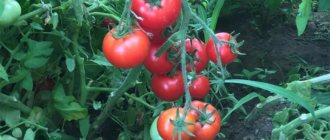Thanks to the work of breeders, there is already a huge number of different varieties of tomatoes. And also their hybrids. The choice is so huge that in the store you can even get lost in front of the stand with tomato seeds. Some are zoned for the north, others for the south. Still others have an unusual color. And the fourth have an original shape of the fruit. The Eagle's Beak tomato falls into the latter category. Because that is why it is named so unusually. In addition to its interesting shape, this variety has other advantages. It gives a very good harvest. And also very tasty and juicy fruits.
Tomato Eagle Beak: description and characteristics of the variety
Tomatoes Eagle Beak: photo of the variety
The Eagle's Beak tomato variety was obtained thanks to the work of Siberian breeders. It can be grown in a greenhouse. And also in an open area. In terms of ripening time, this variety is mid-season. This is an indeterminate culture. The shrub has a spreading form. However, the shoots are not very powerful.
This variety is self-pollinating; for this reason, the Eagle's Beak tomato is often grown in open ground conditions.
The Eagle's Beak tomato has a good degree of resistance to low temperatures. This variety shows decent results, even if the summer was very short, and even with return frosts in spring, plants are able to develop normally and form ovaries. In the autumn, tomatoes, as a rule, are already fully ripened. If you follow the basic rules for growing, you can achieve very good results, for example, you can get about 8 kilograms of vegetables from one plant. The bush reaches approximately 1.5 meters in height, the foliage has a standard shape. And also no different from the leaves of other tomato varieties. They are quite large in size and bright green in color. Inflorescences, as a rule, form on top of the tenth leaf.
Growing rules
Agricultural experts recommend not planting more than 3 bushes per meter of area. Thickening leads to:
- reduction in yield;
- fruit shrinkage due to light deficiency;
- risk of infectious diseases and pest attacks in conditions of poor ventilation.
“Eagle beak” is planted, and the bush is formed into 1-2 stems. The task of gardeners is regular watering and periodic application of fertilizers.
The variety is quite new, still unknown to many. However, if you read reviews of the “eagle beak” tomato from those who planted it, you will immediately notice: the tomato is undemanding in care and is suitable for growing even in the harsh conditions of Siberia, especially since the tomato was bred by local breeders.
From seedlings to harvest
Seeds are sown in planting containers with soil in:
- early April or late March – Siberians;
- all of March – Middle zone;
- February – Southerners.
Fertile soil is suitable for the culture, the base of which consists of garden soil and humus. Superphosphate and wood ash are used as additional feed.
A few rules for growing eagle beak tomatoes:
- Seeds are sown no deeper than 2 cm.
- The container with seedlings is covered with film and placed in heat and light.
- After the growth of two full-fledged leaves, the seedlings are picked - planted in peat or plastic pots.
- Water only with warm, well-settled water. It would not be superfluous to feed the “eagle’s beak” with complex fertilizer immediately after picking, no later than a week before the seedlings are planted in the garden.
- The ideal time for replanting is when the soil is warm, eliminating the possibility of night frosts. In the Center it is May, the first half. Siberians are transplanted even at the beginning of June. And in the south, the tomatoes planted in April have already begun to bloom and bear fruit.
- Transplant the seedlings into the prepared soil; place one tablespoon of fertilizer in each hole.
The first week is the most important. For a couple of days the bushes stand covered with newspapers or white agrotextiles. Shading will help young plantings take root faster. The gardener monitors weather forecasts in order to cover the ground tomatoes with covering material in case of cold weather.
Loosening, maintaining soil moisture, weeding are constant concerns for summer residents. Mulching with straw, a thick layer of humus or compost, or rotted sawdust after soaking in urea will help relieve the work schedule.
Caring for the Eagle Beak tomato variety
When planting the Eagle Beak tomato variety, you must follow a certain planting pattern. Plants should not be located too close to each other. It is best to plant no more than three tomato bushes per square meter.
How long the shoots of a given variety will reach depends greatly on the growing conditions of Eagle's Beak. In open ground conditions, the height reaches approximately 120 centimeters. If agricultural technology is maintained at the proper level, the plant can grow 150 centimeters in length. As for the conditions of greenhouses and greenhouses, the bushes reach 180 - 200 centimeters. In any case, the plants must be secured to supports. Because the stems of this variety are quite fragile in structure. And they can break under the weight of the fruit. And also from a gust of wind.
For normal growth and development of plants, it is necessary to form a bush from time to time. And also remove unnecessary stepchildren. It would be a good idea to use growth stimulating drugs. In this way, it will be possible to positively influence the quality of the future harvest.
The ovaries of the Eagle Beak tomato variety are formed throughout the summer and until the autumn period. For this reason, the yield of Eagle Beak tomatoes is so large that the harvest is harvested in more than one go. As a rule, vegetables are harvested two to three times per season.
Caring for mature plants
After transplantation, agricultural technicians recommend leaving the tomatoes “alone” for 7-10 days. During this period, plants adapt to new living conditions and any intervention will not be beneficial. Two weeks after planting, you can carry out the first fertilizing. It should consist of more than 50% nitrogenous compounds. After all, tomatoes still need to increase their green mass.
Find out more: Tomato nutrition that improves taste
The second feeding is recommended before flowering. At this time, the culture requires increased nutrition. It is recommended to apply phosphorus-potassium fertilizers at the root, for example, an infusion of ash (500 g per bucket of water). And for better formation of ovaries, it is good to spray the bushes with a solution of boric acid.
Related article:
5 main rules for watering tomatoes for an excellent harvest
In the future, fertilizing can be repeated after 10-14 days, alternating the compositions.
Tall Eagle Heart and Eagle Beak need bush formation. The originator of the variety, the Siberian Garden company, recommends growing varieties with two stems. The remaining side steps should be removed. In the northern regions, the middle zone and Siberia, in July you can pinch the tops of the bushes. Topping is carried out so that all the fruits have time to form and ripen.
Characteristics of the fruits of the Eagle Beak variety
Tomato variety Eagle Beak: photo
It is worth noting that the fruits of this variety have a very interesting shape. The tip of such a tomato is slightly elongated and curved, thereby resembling the beak of a bird of prey. When the fruit has not yet reached maturity, it has a pink tint inside and outside. And the ripe fruit turns a beautiful dark pink color.
The fruits of this variety appear quite quickly. From the moment the sprouts form until the first harvest, about 100 days pass, as a rule. Many gardeners who grow Eagle's Beak tomatoes on their plots note that this variety produces fairly large fruits. As a rule, the largest specimens grow at the very beginning of the harvest period.
The largest tomatoes can weigh from 800 grams to 1 kilogram. Further, the fruits usually weigh about 400 grams. On average, one fruit weighs about 500 grams. The taste of these tomatoes is at a high level. The inside of the fruit has a fleshy structure. It also has a lot of juice and sugars. The fruits can retain their quality after being picked from the branch, usually for one week.
As for the scope of application of this variety, it is universal. Tomatoes are a great addition to fresh salads. They are also suitable for preparing various preparations for the winter. Tomatoes make very tasty juices, sauces, and pastes. As a rule, such tomatoes are not used whole due to their size.
Best reviews from our readers
Positive opinions about the Eagle's Beak tomato characterize the variety as productive and universal in use. Vegetable growers point to excellent taste and good fruit set.
The large-fruited variety is often called the best; it stands out for its exotic appearance and color. The main factor influencing the quality of the fruit is crop care. Productivity and taste depend on compliance with the rules of agricultural technology.
Tomatoes Eagle Beak: pros and cons of the variety
Like any other variety or hybrid, Eagle Beak has a number of positive qualities. Of course, there are some downsides. Let's look at the main ones. Tasters evaluate the taste qualities of these tomatoes at the highest level. The fruits of the Eagle's beak have an unusual shape. And also attractive coloring. This variety shows very good results in terms of yield. The fruits are large in size and can be stored for a long time. This variety of tomatoes has a fairly strong immunity against major diseases of fungal and viral origin.
As for the shortcomings, unfortunately, we cannot do without them. This variety produces fairly large fruits. For this reason, plants must be regularly fed with nutrients. And also monitor the correct watering regime. This variety needs to be planted from time to time. Because its stems grow quite actively. The disadvantages include the need to garter the bushes. This makes the process of caring for plants a little more complicated. It also makes the construction of trellises mandatory.
To summarize, we can say that there are many more advantages. And those factors that are disadvantages, according to summer residents, are no more than recommendations for caring for plants.
How to care
Subsequent care of seedlings consists of timely and sufficient watering, complete feeding with fertilizers and proper pruning of bushes.
Watering
This tomato variety prefers abundant watering at intervals depending on weather conditions (but in any case at least once a week). Regular watering begins a few days after planting the seedlings in the ground and is carried out by carefully pouring water under the bush, during which water drops are not allowed to fall on the leaves.
Feeding
While a plant is gaining green mass, it needs nitrogen, which is best supplied by organic fertilizers. Then the main forces of the bush are directed to the development and ripening of fruits.
During this period, tomatoes already require more useful substances in the form of:
- potassium;
- phosphorus;
- Yoda.
During the season, tomatoes are fed at least 3 times.
Stepsoning
“Eagle beak”, which forms a lush bush, is in great need of pinching. This process rids the plant of useless green mass, saves the vitality of the bush for the development and ripening of fruits and opens access to the sun's rays.
A maximum of 2 stems are left on the bush, cutting off all the leaves from the lower tier. If the plant is excessively thick with green mass, the leaves on each tier are thinned out. The pinching and formation of the bush begins in July, then the process is repeated every ten days.
Remove the stepsons with fingers dipped in a weak solution of potassium permanganate. The use of scissors is not recommended.
Soil care
Like all tomatoes, eagle beak prefers loose soil around the bush. It is advisable to loosen it after each watering, but at least once every two weeks. Loosening is usually combined with weeding.
To optimize the temperature and humidity in the root system, the plant is hilled with moist soil or mulched with humus.
Tying up a bush
Although this variety is semi-determinate, does not grow excessively in height and is subject to active pinching during the season, nevertheless its spreading branches and especially the clusters with numerous heavy fruits require tying up and even supports.
Among the existing methods of tying with stakes, trellises, cages or nets, trellises are mainly used, which are most convenient for this tomato variety. But even they are not able to support excessively heavy clusters with large fruits, which have to be supported with wooden supports.
Preventative treatment
Despite the fact that when it was bred, this tomato variety was given the qualities of resistance to most diseases and pests that affect nightshade crops, caution when growing “eagle beak” will not be unnecessary.
To do this, the following preventive measures are taken:
- The resistance of the variety to tobacco mosaic, late blight and fusarium will be even greater if the soil for seedlings is calcined in the oven and disinfected with a manganese solution;
- to prevent late blight infection, it is useful to treat bushes with preparations containing copper;
- fungal diseases are prevented by treating seedlings with Fitosporin or a weak solution of potassium permanganate;
- the arrival of pests in the form of insects is suppressed by the use of insecticides or the folk method using a decoction of onion peels, chamomile and celandine, as well as soapy water or a manganese solution with ammonia.
How to grow Eagle's beak tomato correctly
If you want to achieve a decent harvest with large and tasty tomatoes, then you need to follow some care rules. This is important at all stages of plant growth and development.
Some summer residents do not like to complicate their lives too much. And he simply buys ready-made seedlings in the store. However, it is better not to do this. Because there is no guarantee that you will get exactly the variety you expect. And you also don’t know what quality seeds were used to obtain these seedlings. It is very important to choose the right seeds for growing seedlings. This applies to store-bought seeds. And also selected from tomato fruits.
Seed calibration is required. To do this, they need to be carefully sorted. And remove those that don't fit. They are deformed, too small, rotten. After this, the selected seeds must be kept in a salt solution for about 15 minutes. Empty seeds will appear on the surface of the water and must be removed. After this, it is necessary to disinfect with a one percent manganese solution. Seeds need to be hardened and germinated. This is done using a saucer and a damp cloth.
How to sow seedlings of the Eagle Beak tomato variety
Tomato variety Eagle Beak: photo of seedlings
Seeds of the Eagle Beak tomato variety are usually sown in March. By the time of sowing, they must be completely processed and in the seedling stage. Plants are planted in their permanent habitat after 60 days. It must be warm enough for this to happen. Tomato seeds are sown in containers or boxes. As for the soil, it can be taken from the beds. It should be quite fertile. It would be a good idea to heat the soil in the oven before doing this. And also add humus.
It is best to use ready-made soil for growing tomato seedlings, which can be purchased at a garden store. This mixture contains a sufficient amount of essential nutrients.
When the soil is ready, place it in a container and water it a little. Then grooves are made; there should be a distance of about two to three centimeters between them. As for the depth of such grooves, it should be a centimeter to one and a half. There should also be a space of one to three centimeters between the grains. After this, add a thin layer of loose soil and moisten with a spray bottle. Cover the containers with polyethylene. They should be in this form before the first shoots appear. Then the polyethylene is removed and the containers are transferred to a well-lit place. If additional illumination is needed, use special lamps. Picking into separate glasses is carried out when a pair of true leaves appear on the plants. After this, the cups need to be moved to the shade. The plants should grow a little and get stronger, and then they can be returned to a sunny place. In seven to ten days, the seedlings must be hardened; to do this, they must be taken out into fresh air.
Features of agricultural technology
Indeterminate tomatoes, such as Eagle Beak and Eagle Heart, are unpretentious, but to obtain a rich harvest, it is necessary to properly care for the plants throughout the entire growing season - from seed germination to the end of the fruiting period.
What is a determinate and indeterminate variety of tomatoes?
Growing seedlings
The timing of sowing seeds should be calculated taking into account the region and growing conditions. In the middle zone, the optimal sowing time is March, in Siberia and the Urals - the first days of April. When planning sowing, it is recommended to focus on a simple rule - seedlings are ready for transplanting after 50-60 days from germination. By the time the seedlings are moved, the soil should have already warmed up to 16 C, and the likelihood of return frosts will be close to a minimum.
Related article:
Which pink tomatoes have high yields?
To improve the germination percentage, the seeds need to be prepared for sowing:
- treat with a disinfecting solution (soak for three hours in a pink solution of potassium permanganate);
- treat with growth stimulants (buy ready-made or use aloe juice in a 1:1 ratio with water).
Soil for sowing can be purchased ready-made or prepared independently. The soil collected from the garden plot must be disinfected. To do this, it is recommended to pour it first with boiling water and then with a strong solution of potassium manganese. Specialized formulations do not require additional processing.
It is best to sow seeds in boxes. Two weeks after germination, the seedlings need to be picked into separate containers, selecting the strongest ones from the total quantity. Pots with tomatoes should be placed in the brightest and warmest place, without drafts. Small bushes need to be watered when the soil dries out and very carefully, using a syringe or a teaspoon. Also, during the first month, while daylight hours are short, it is recommended to supplement the seedlings with phytolamps.
Containers for sowing seeds, used from year to year, must be thoroughly washed and treated with potassium permanganate before sowing.
Planting tomatoes in the ground
To plant plants in a permanent place, stable warm weather is needed, and the soil must warm up well. As a rule, this is the end of May - beginning of June. The soil must be prepared at the time of planting. It must be disinfected, loosened, and well fertilized with organic matter. About fifty centimeters should be left between the planting holes. In each hole you need to add a tablespoon of fertilizer based on phosphorus and potassium. The root system is covered with loose soil. After planting, you need to water the plants. The water should not be cold.
Brief information about the variety
- Fruits and bush : bright crimson tomatoes, weight – 300-800 g; The bush is spreading, indeterminate, reaching a height of 150-200 cm.
- Productivity : 6-8 kg per bush.
- Resistance : the tomato easily tolerates frost, is resistant to late blight, fusarium and tobacco mosaic.
- Distribution : all regions of Russia. In the south of Russia and in areas with a temperate climate, planting in open ground is allowed; in Siberia, the variety is grown in a greenhouse.
- Application : the fruits are suitable for salads, as well as for processing (juices, ketchups, pastes).
- Planting : seedling method. Sowing - 60 days before transplantation. Tomatoes are transferred to a permanent place of growth in May; the planting pattern is 70x90 cm.
- Soil : loose, light, nutritious.
- Care : abundant watering - once a week, fertilizing - once every 14 days, constant pinching (from July until the last fruits are collected), formation - 1-2 stems.
- Ripening period : mid-early variety - the crop ripens in early to mid-July, bears fruit until the end of September. Tomatoes are suitable for long-term storage.
Watering and fertilizing
This variety is very demanding on abundant watering. This should be done at least once a week. Much depends on the weather. It is necessary to add nutrients for tomatoes from time to time; this is done at least three times per season. Many summer residents use ammonium sulfate, Plantafol or Kemira for this. This applies to mineral fertilizers, but organic fertilizers can be added more often. Compost can be used for this purpose. As for manure or bird droppings, be careful here. It is necessary to maintain the correct proportions, otherwise there is a risk that you will cause irreparable damage to the roots of the plants.
When inflorescences form, it is necessary to exclude nitrogen-containing fertilizers. If there is too much nitrogen, there is a risk that the ovaries may not form. Excess stepsons of this variety must be removed periodically, the same applies to the lower leaves. If you see that the bush is too thick, then you need to partially remove the leaves. So, the sun's rays will fall evenly on the entire plant. The formation of tomatoes begins in July. This should be done at intervals of approximately ten days. Plants also need to be tied to reliable supports.
This variety can sometimes be attacked by late blight.
To prevent this from happening, you need to spray the plant with Bordeaux mixture for the purpose of prevention. If the fungus is still found on the plant, then you can use Fitosporin for treatment. As for insect pests, a solution with soap or a cleaning infusion works well against them. Tomato Eagle Beak: video
Sowing dates and care features
To get a good harvest, seedlings need to be planted on time - it’s bad if they overgrow or are too small when moved into the ground. In both cases, additional time will be required for the tomatoes to adapt, which will delay the appearance of the first ripe fruits.
The eagle beak has an average maturation period. It is recommended to plant 60-65-day-old seedlings:
- into the greenhouse when the soil at a depth of 10 cm warms up to 10° C;
- to the garden - no earlier than the soil temperature reaches 15° C.
Tomatoes are sowed based on the long-term weather forecast and their own climatic conditions.
Sowing seeds
It is better not to make soil for seedlings yourself, but to buy it in a specialized store. All the fertilizers that tomatoes need are already there, and you won’t have to feed them before picking.
Although the finished substrate is usually made from peat and must undergo disinfection, it is recommended to be on the safe side. To do this, place the unopened bag in an enamel or galvanized bucket, pour boiling water over it, and cover with a lid. Leave until cool.
Eagle beak seeds are heated, pickled and soaked until they swell. The remaining operations - culling, bubbling, germination or hardening with high-quality planting material - are not necessary.
The containers are filled with a damp substrate, the seeds are planted to a depth of 1 cm. In a common container, the grains are laid out in rows every 1-2 cm. The furrows themselves are drawn at a distance of 4 cm - this will allow you to loosen the substrate and water the tomatoes at the root.
Then the containers are covered with glass or film and kept at a temperature of 23-25° C. The cover is removed daily, condensation is removed, and if necessary, the soil is moistened with a household spray bottle.
Growing seedlings
As soon as the seedlings hatch, the seedlings are placed in a cool, bright room with a temperature of:
- during the day – about 16° C;
- at night - about 6 degrees lower.
Then they are transferred to heat, and then grown at 20-25 ° C, additionally illuminated for up to 12-14 hours per day. When opening, 2-3 true leaves are dropped into a separate container.
After 2 weeks, the first feeding is given. You need to use a complete mineral complex, in which nitrogen will predominate - it is necessary for the crop to grow green mass.
Tomatoes are hardened 7-14 days before moving to a permanent place. First, leave it outside for 20 minutes, gradually increasing the time. For the last 1-2 days, the seedlings should spend the night in the open air.
Aftercare
Normally developed tomatoes are planted at the cotyledons or the first true leaf. Only the elongated seedlings are buried. Water abundantly and then leave without moisture for 10-14 days. So the root will rush deep in search of water. There is no need to pay attention to the leaves that fall during the day.
The signal for watering will be the plates that have not returned turgor overnight. In the future, tomatoes need to be moistened regularly and moderately. The Eagle's Beak variety produces large fruits; alternating periods of drought and heavy watering will lead to their cracking.
The first feeding after transplantation should be nitrogen. As soon as the second flower cluster extends, the tomato is transferred to the generative stage of development. That is, they forcibly stop the growth of green mass, directing all the plant’s forces to flowering, forming ovaries and filling fruits. To do this, reduce nitrogen in fertilizers to a minimum and provide more potassium, calcium and phosphorus.
Form the Eagle's beak into two stems. They are firmly tied to the support, and the stepsons and leaves under the fruit cluster that has begun to fill are promptly removed.











